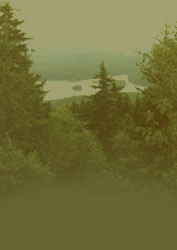|
Do you have something
happening in your corner of Washington? - Please call a member
or e-mail your observations to have them included here
This Month:

Picture credit - Kara Bonsack
Much of NH is seeing a great crop of acorns this year. Mast crops are typically defined as the fruit of forest trees. There are a number of factors that contribute to heavy mast crops. Climatic factors such as wind, late frost, prolonged rain, humidity and temperatures can all affect flowering and pollination, and all of these must cooperate for fertilization to occur. Only once this has happened is there a chance that a seed will mature and eventually grow into a tree. Acorn production varies from tree to tree, so genetics also play an important role in acorn production.
Percentage-wise, very few acorns will survive to grow into seedlings. When considering all of the environmental factors, the fact that a huge number of fruits are lost to early abscission(drop), and that acorns serve as a fundamental food source for so many organisms, it’s pretty amazing that a few of them actually survive and grow into the mighty oaks we know and love.
Animals, insects, birds and microorganisms (mainly fungi) all use acorns as a food source. Also of interest, white oaks mature seeds in one season, while red oaks require two. It is generally agreed upon that oaks and other mast-producing trees must store resources for a time between large crops. Therefore, it makes some sense that after a year or two of heavy production, depending on the species, we might expect a period of lower production until energy reserves are built back up. Extreme drought conditions could play a role in how quickly trees are able to replenish reserves.
Animal populations also fluctuate with mast crops. Simply stated, in the years immediately following a good nut crop there is often an increase in the small mammal populations like squirrels, chipmunks and mice. In these years, very few acorns will have the opportunity to sprout before they are eaten. The years following will see a rise in the hawk and owl populations that feed on those small mammals, helping to balance out the small mammal population once more. Once populations of small mammals decline, the opportunity for subsequent crops of nuts to sprout and grow increases, and the cycle continues.
Article by Jeremy DeLisle, UNH Cooperative Extension Education Center Coordinator, found at: UNH Cooperative Extension Education Center
October:

Picture credit - Jed Schwartz
We recently held our fall hike and had a great time on the trail. We encourage everyone to take advantage of the great hiking to be had in Washington and beyond. New Hampshire has a program to promote safe hiking around our state called hikeSafe.
They want you to be safe on the trails! The NH Fish and Game Department and the White Mountain National Forest are partners in a mountain safety education program called "hikeSafe" to help get the word out on what hikers need to know.
Learn more about the Hike Safe Card
As part of this program, the Hiker Responsibility Code is posted on hikeSafe signs at all major trailheads in New Hampshire. The code applies to all hikers, from beginners on a short hike to experienced outdoor enthusiasts embarking on an expedition. Please practice the elements of the code and share the code with fellow trekkers. This will help increase responsibility and reduce the need for Search and Rescue efforts.
hikeSafe Hiker Responsibility Code
You are responsible for:
• Knowledge and gear. Become self reliant by learning about the terrain, conditions, local weather and your equipment before you start.
• To leave your plans. Tell someone where you are going, the trails you are hiking, when you’ll return and your emergency plans.
• To stay together. When you start as a group, hike as a group, end as a group. Pace your hike to the slowest person.
• To turn back. Weather changes quickly in the mountains. Fatigue and unexpected conditions can also affect your hike. Know your limitations and when to postpone your hike. The mountains will be there another day.
• For emergencies. Even if you are headed out for just an hour, an injury, severe weather or a wrong turn could become life threatening. Don’t assume you will be rescued; know how to rescue yourself.
• To share the hiker code with others. ?
hikeSafe: It's Your Responsibility.
Additional resources for hiking preparation, including how to plan your trip and what to know if you're hiking with children or a group, can be found at hikesafe.com
The Ten Essentials for Hiking:
• Map
• Compass
• Warm Clothing:
Sweater or Pile Jacket, Long Pants (wool or synthetic), Hat (wool)
• Extra Food and Water
• Flashlight or Headlamp
• Matches/Firestarters
• First Aid Kit/Repair Kit
• Whistle
• Rain/Wind Jacket and Pants
• Pocket Knife
Get out on the trails and have a great experience!
Information found at: NH Fish and Game
September:
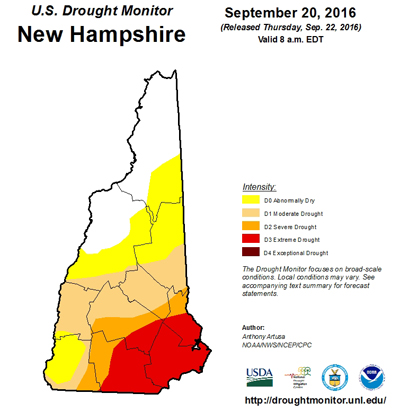
Picture credit US Drought Monitor
Arin brought up how dry it has been this summer after a winter without much snow. Many might not realize that we are in a severe drought area in New Hampshire.
Although New Hampshire is typically thought of as a water-rich state, there are times the demand for water can be difficult to meet. A combination of increased population and extended periods of low precipitation can cause reduced water supplies in the state. Drought is a normal, recurrent feature of climate and it occurs almost everywhere.
A combination of a below average snowpack in the spring, little precipitation to recharge the groundwater, an increase of evapotranspiration in the summer, and the inability of New Hampshire watersheds to store large volumes of water due to their geology has landed the northern half of the state in abnormally dry conditions and the southern half in severe drought. As a result of the current conditions and the long-term forecast, the New Hampshire Department of Environmental Services (NHDES) is urging New Hampshire residents to conserve water as long as drought conditions persist.
The drought condition is a very slow-moving natural disaster that may continue to worsen and the public’s assistance in conserving water is key to sustaining existing water supplies.
Abnormally dry to extreme drought conditions have persisted through the majority of the summer, leading to the failing of some private wells. To prevent further water shortages, the New Hampshire Department of Environmental Services (NHDES) is advising water be reserved for only indoor uses and that wise indoor use be practiced per the actions below. Also, be aware that municipalities have the authority to restrict residential lawn watering for public and private well users to protect the resource for the whole.
To stay informed on the latest drought conditions and current drought related information go to the NHDES Drought Management Program webpage: NH DES Drought page
August:
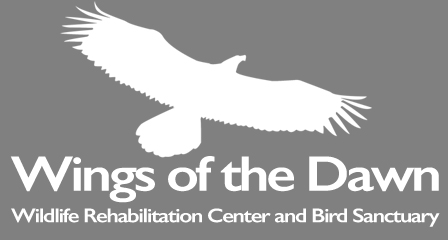
Picture credit Wings of the Dawn
Johanna recently brought an injured hawk to Wings of the Dawn for rehabilitation. Here is more information about this wonderful center and their work and what to do if you find injured wildlife or birds.
Wings of the Dawn strives to provide the best wildlife rehabilitation services possible. With every rescue, their goal is to rehabilitate the animal back to full health and release it back into the wild. They believe that each animal should live in as natural a habitat as possible in the wild. They provide professional and humane care in all phases of wildlife rehabilitation, respecting the wildness and maintaining the dignity of each animal in life and in death. They aim to rehabilitate and release each animal back to the wild in a healthy state that will insure their survival.
Rescuing Injured Wildlife - Wings of the Dawn rehabilitators are trained and experienced in rescuing and rehabilitating all birds and small mammals. If you have found injured wildlife, or abandoned young wildlife, please follow their quick care guide (see below) and then call Wings of the Dawn at (603)428-3723. By phone, Wings of the Dawn can offer further advice as to what you should do to help the wildlife and will tell you whether it is necessary to bring the injured wildlife to Wings of the Dawn in Henniker or to another wildlife rehabilitation center that is closer to you.
1. Call Wings of the Dawn at (603)428-3723 before approaching any animal, unless you feel that the animal is in immediate danger.
2. Do not give the animal any food or water unless instructed to do so by Wings of the Dawn or other trained wildlife rehabilitators. Feeding an animal an incorrect diet can result in injury or death. In addition, a captured animal may get food and water stuck in its fur/feathers potentially leading to discomfort and hypothermia.
3. Place the animal in an appropriately-sized, secure box with a towel or paper towel on the bottom. Make sure the box has holes in the lid.
4. Keep the animal in a warm, dark, quiet place.
5. Leave the animal alone. Remember human noise, touch and eye contact are very stressful to wild animals.
6. Follow any further instructions given to you by Wings of the Dawn. If necessary, do not hesitate to call (603)428-3723 again.
For more details on care for temporary care for injured wildlife please visit this website and/or call Wings of the Dawn at (603)428-3723.
Education Is Power - Wings of the Dawn has an education program too!
Wings of the Dawn educational outreach programs are both fun and educational. They usually cover the natural history of the birds and their importance to the environment. Of course, the most exciting part of every presentation is a demonstration by one of Wings of the Dawn’s “education birds”, which are birds that rescued and rehabilitated by Wings of the Dawn, but deemed unable to be released back into the wild. If you are interested, please apply on their website: wingswildlife.org.
If you have any more questions, feel free to contact Wings of the Dawn by email, at info@wingswildlife.org
As a non-profit, Wings of the Dawn relies on your donations to continue operating and saving wildlife.
Contact Info:
P.O. Box 53, Henniker, New Hampshire 03242
Phone: (603)428-3723
info@wingswildlife.org
July:
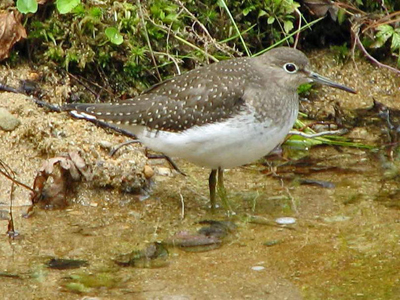 Picture credit wikipedia commons, Dick Daniels Picture credit wikipedia commons, Dick Daniels
Johanna has seen Solitary Sandpipers around Washington! You think of Sandpipers nesting at the beaches near the ocean but you can see this sandpiper around fresh water ponds in town.
Almost all of our sandpipers migrate in flocks and nest on the ground, but the Solitary Sandpiper breaks both rules. In migration it is usually encountered alone, along the bank of some shady creek. If approached, it bobs nervously, then flies away with sharp whistled cries.
In summer in the northern spruce bogs, rather than nesting on the wet ground, the Solitary Sandpiper lays its eggs in old songbird nests placed high in trees. It uses nests built by songbirds such as American Robin, Rusty Blackbird, Bohemian Waxwing, Eastern Kingbird, Gray Jay. The nest chosen is usually in spruce or other conifer, sometimes in deciduous tree, 4-40 feet above ground.
It mostly forages in shallow water, moving about actively, picking items from surface; also probes in water and mud. While walking in water, may pause and quiver one foot, presumably to stir up small creatures from the bottom.
Their diet consists of insects and other small aquatic creatures. Feeding on many insects of water and shore, including beetles, dragonfly nymphs, grasshoppers; also crustaceans, spiders, worms, mollusks, occasionally small frogs.
It is a long-distance migrant, wintering mostly in South America, especially around swamps and riverbanks in the Amazon Basin., apparently migrating mostly alone and at night.
Information found at:Audubon Field Guide
June:
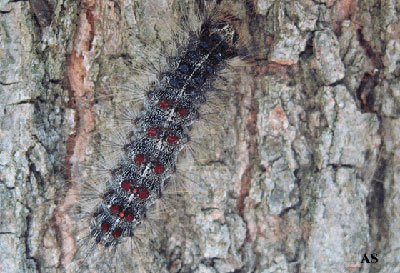 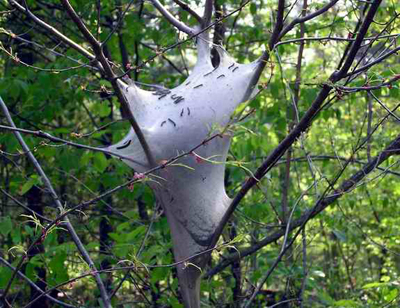
Picture credit GypsyMothAlert.com Picture credit SierraPatomac.org
County foresters and forest health specialists are reporting that three varieties of leaf-eating caterpillars are now being seen in many parts of the Granite State: eastern tent caterpillars, forest tent caterpillars and gypsy moths. While these bugs are responsible for defoliating trees and the eastern tent caterpillars create unsightly webs, for the most part they are nothing to worry about.
“The eastern tent caterpillar is common this year and doing some damage to cherry and other fruit trees,” says Kyle Lombard, forest health specialist at the New Hampshire Division of Forests and Lands. “It rarely kills the tree and it’s not really a forest pest of consequence.”
Dode Gladders, UNH Cooperative Extension’s Sullivan County forester, said he has seen more eastern tent caterpillars this year than last year and there are a few reports of forest tent caterpillars. Forest health specialists at the New Hampshire Division of Forests and Lands are receiving reports of high numbers of forest tent caterpillars and gypsy moths but haven’t heard of any defoliation by these pests. Each of these pests has several predators that help keep their populations in check. “Trees have adapted to occasional defoliation and other stresses,” says Gladders. “No doubt, trees do better without being stripped of their leaves, but they are amazingly resilient and healthy trees recover as long as they aren't defoliated yearly.”
Here are details on what to look for, what to worry about and what not to worry about:
Eastern tent caterpillars are the most visible. They weave webs, mostly in cherry trees, stripping the tree bare. They are more of a nuisance than a threat to trees, rarely killing healthy trees. They have nearly completed feeding and will soon pupate, emerging as moths in July. Defoliated trees will produce new leaves once the feeding stops. Forest tent caterpillars are the “tent caterpillars” that don't make tent-like nests. They are active now. They feed on hardwoods including oak and sugar maple. Like their relative the eastern tent caterpillar, they don't cause irreparable harm to healthy trees.
Gypsy moths are also starting to feed. Because this pest caused extreme defoliation in the 1980s and 1990s, this caterpillar gets blamed for most of the work of the other two. However, a fungus introduced in the early part of the last century is preventing gypsy moth numbers from exploding and it is unlikely they will defoliate as extensively as in the past.
Populations of insects rise and fall with natural controls that keep them in check. Insect parasites, predators, viruses, fungus, weather extremes and even starvation when populations exceed the food supply all help control them. There is little we can do to prevent them from attacking, though there are some effective treatments for specimen trees.
For more information on appropriate treatments, call UNH Cooperative Extension’s Education Center's toll-free information line at 877-398-4769.
Information found at:UNH Cooperative Extension
May:
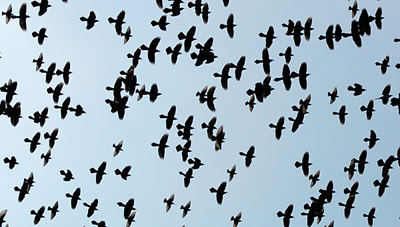
Picture credit Robert Baker / PFW / Cornell- All About Birds
We wondered what is a group of Birds called?
On a good day in the field, a birder might see a raft, a band, a host, a chime and even a kettle. But what exactly are they seeing? Different types of birds have different collective nouns to describe large groups, and while many of the terms are obsolete, seldom used or just plain silly, they are still familiar to birders. Many of the terms are descriptive not only of the group of birds but also of their behavior or personalities, and birders who understand these esoteric words and can apply them to the appropriate birds will enjoy birding even more. Read on to find out what your favorite birds are called, in a group:
Blue Jays: a band, scold or party
Buzzards: a wake
Bitterns: a sedge
Crows: a hover, muster, parcel, murder, horde or parliament
Cranes: a herd, siege or sedge
Chickens: a brood, clutch, flock, run or peep. Chicks: a clutch or chattering
Chickadees: a banditry
Ducks: a raft, paddling or bunch (on the water), a team, brace, bed, flight or flock (in the air), a badling
Doves: a flight, due or dole or plague
Eagles: a convocation or congregation
Finches: a charm
Geese: gaggle or flock (on the ground), skein or wedge (in the air), a plump (on the water)
Grouse: a pack or covet
Guinea Fowl: a confusion or rasp
Gulls: a colony
Hawks: a cast, kettle or boil
Hummingbirds: a charm, glittering, shimmer, tune, bouquet or hover
Larks: a bevy, exaltation or ascension
Loons: a raft, asylum, cry or water dance
Magpies: a tittering, tiding, gulp, murder or charm
Mallards: a sord or brace
Owls: a parliament, stare, wisdom, bazaar or study
Peacocks: a muster, ostentation or pulchritude
Pheasants: a head, nye, nest, nide, bouquet or bevy
Pigeons: a kit, flock or flight
Quail: a bevy, drift, flush or rout
Ravens: an unkindness, murder, congee, horde or conspiracy
Sparrows: a host, quarrel, flutter, crew or knot
Swallows: a gulp or flight
Swans: Wedge, ballet, lamentation, whiteness, regatta
Turkeys: a rafter, gobble, clutch or gang
Vultures: a committee, venue, volt or wake
Waterfowl: a bunch, knob, trip or plump
Woodpeckers: a descent
There are many more if you are interested!
Information found at:Birding.about.com and HintsandThings.com
April:
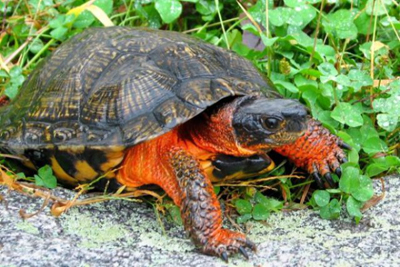 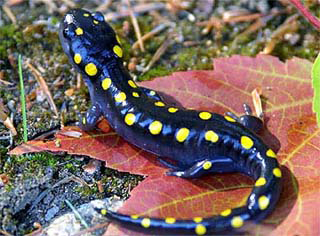
Picture found at Maine FG Photo by NHFG/Victor Young
Reptile and Amphibian Reporting Program (RAARP)
Spring is a great time to get outside and look for snakes, salamanders, turtles and frogs. They are on the move, looking for mates, nesting and making lots of noise.
RAARP is a program coordinated by the NH Fish and Game Nongame & Endangered Wildlife Program where volunteers report sightings of reptiles and amphibians from spring peepers to snapping turtles. These reports are extremely valuable to biologists.
Observations are used to determine the distribution of all reptiles and amphibians within New Hampshire. Reports of less common species are very important. Verified reports of rare species locations are mapped and stored in a database used for land protection and conservation purposes. Reports should be accompanied by a clear photograph whenever possible. To be added to the spring mailing list, please contact the NH Fish and Game Wildlife Division: (603) 271-5859 or email: wildlife@wildlife.nh.gov.
RAARP participants must obey all local, state, and federal laws while collecting reptile and amphibian location data. Observers are advised to get landowner permission before going onto private property.
There are 3 ways to report your sightings; by email, online and by printing and mailing a reporting form. They have tools for observers on their website, including keys to what you might find, how to photograph your find, field techniques and more. They also have a Vernal Pool Documentation Manual and form available for download, in case you want to visit a vernal pool.
Happy hunting and don't forget to report what you find! Leave what ever creatures you find where you found them, but bring home a picture, if you can.
All you need to know can be found here:NHFG RAARP program
March:
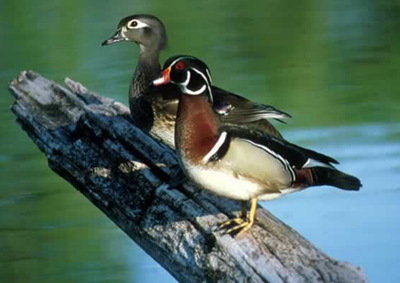
Picture found at NHPTV.org
Johanna is lucky enough to have Wood Ducks living on her beaver pond!
The Wood Duck is one of the most stunningly pretty of all waterfowl. Males are iridescent chestnut and green, with ornate patterns on nearly every feather; the elegant females have a distinctive profile and delicate white pattern around the eye. These birds live in wooded swamps, where they nest in holes in trees or in nest boxes put up around lake margins. They are one of the few duck species equipped with strong claws that can grip bark and perch on branches.
Wood Ducks thrive in bottomland forests, swamps, freshwater marshes, and beaver ponds. They are also common along streams of all sizes, from creeks to rivers, and the sheer extent of these make them an important habitat.
Wood Ducks pair up in January, and most birds arriving at the breeding grounds in the spring are already paired. The Wood Duck is the only North American duck that regularly produces two broods in one year.
Breeding pairs search for nest cavities during early morning. The male stands outside as the female enters and examines the site. They typically choose a tree more than 1 foot and often 2 feet in diameter, with a cavity anywhere from 2–60 feet high (higher sites seem to be preferred). Nest cavities can have openings as small as 4 inches across, and these may be preferred because they are harder for predators to enter. These cavities are typically places where a branch has broken off and the tree's heartwood has subsequently rotted. Wood Ducks cannot make their own cavities. When natural cavities for nesting are scarce, and the Wood Duck readily uses nest boxes provided for it. If nest boxes are placed too close together, many females lay eggs in the nests of other females, leave them to be raised by the other female.
The Wood Duck nests in trees near water, sometimes directly over water, but other times over a mile away. After hatching, the ducklings jump down from the nest tree and make their way to water. The mother calls them to her, but does not help them in any way. The ducklings may jump from heights of over 50 feet without injury. The newly hatched young will follow their mother to a nearby secluded pond to devour plant and insects quickly growing to adult size by late summer.
Wood Ducks eat seeds, fruits, insects and other arthropods. When aquatic foods are unavailable they may take to dry land to eat acorns and other nuts from forests and grain from fields.
For many years, the Town of Deering's Conservation Commission has had a wood duck box program, installing wood duck nesting boxes on many of their town ponds and beaver ponds, to encourage the nesting of these beautiful ducks.
Information found here: Cornell University, All About Birds
February:
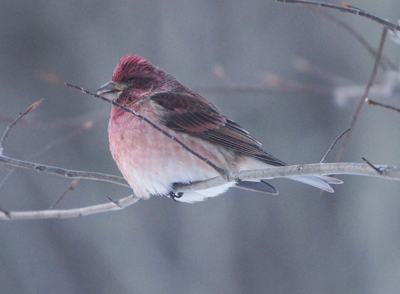
Picture by Jed Schwartz
The Purple Finch is the bird that Roger Tory Peterson famously described as a “sparrow dipped in raspberry juice.” The Purple Finch is the state bird of New Hampshire.
Several of us have had Purple Finches visiting our bird feeders this winter, after not seeing them for years.
For many of us, they’re irregular winter visitors to our feeders. Among the small forest birds like chickadees, kinglets, and nuthatches, Purple Finches are large and chunky. Their powerful, conical beaks are larger than any sparrow’s. The tail seems short and is clearly notched at the tip.
Male Purple Finches are delicate pink-red on the head and breast, mixing with brown on the back and cloudy white on the belly. Female Purple Finches have no red. They are coarsely streaked below, with strong facial markings including a whitish eyestripe and a dark line down the side of the throat.
Separating them from House Finches requires a careful look, but the reward is a delicately colored, cleaner version of that red finch. The purple finch population has declined sharply in the East due to the house finch. Most of the time, when these two species collide, the house finch outcompetes the purple finch.
Purple Finches readily come to feeders for black oil sunflower seeds. You’ll also see them in forests, where they can be noisy but hard to see as they forage high in trees, you’re likely to hear their warbling song from the highest parts of the trees.
In winter they may descend to eat seeds from plants and stalks in weedy fields. Their flight is undulating.
Purple Finches breed mainly in coniferous forests or mixed deciduous and coniferous woods. During winter you can find them in a wider variety of habitats, including shrub lands, old fields, forest edges, and backyards.
Information found here: Cornell University, All About Birds
January:
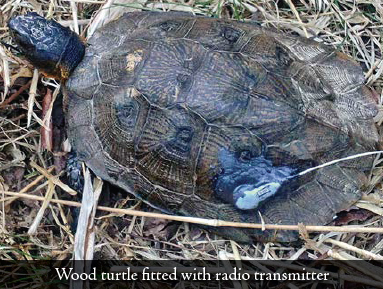
Picture found at NH F&G WildLines
NH Army National Guard Helps Monitor Wood Turtles
The New Hampshire Army National Guard is an outstanding partner of Fish and Game's Nongame Program. The Guard houses the captive-rearing operation for the Karner blue butterflies and helps conduct controlled burns on the Concord Pine Barrens habitat, playing a critical role in the recovery of the Karner blues. Guard members also assist with telemetry tracking of hognose snakes and monitoring of wood turtles.
In 2015, Guard Conservation staff Arin Mills and Kasia Kieleczawa worked with Nongame Program biologists to conduct three targeted river surveys in an effort to better understand wood turtle population and distribution. Four turtle were fixed with radio transmitters and tracked weekly throughout the summer to gain information about the turtle's habitat use at the site. This information will be used to ensure the Guard's effective future planning and decision-making for projects and activities onsite.
"Working with New Hampshire Fish and Game biologists on this project has allowed us to gain a greater understanding of this declining species, both on the Guard's property and throughout the state"' says Mills. "We look forward to continuing the study next season and hope the Guard's assistance will help New Hampshire Fish and Game develop effective long-term management strategies for protection of the species."
We are proud to call Arin a long-time member and Vice Chair of the Washington Conservation Commission. She brings a wealth of knowledge to us, along with a devotion to her work in conservation.
Information found here: NH Fish and Game WildLines
To view yearly archives of our "New In
Nature" series click on year you wish to see.
2002
2003
2004
2005
2006
2007
2008
2009
2010
2011
2012
2013
2014
2015
|


